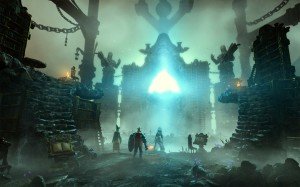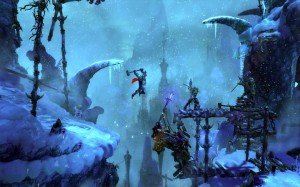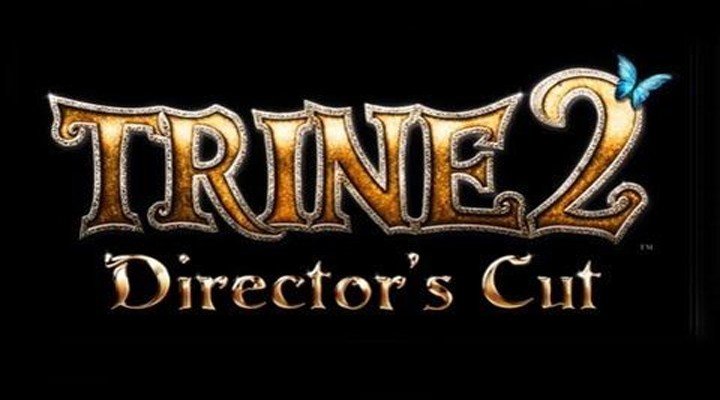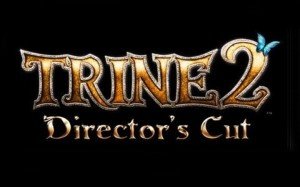The original Trine was a welcome surprise with its combination of luscious visuals and 2D pairing of platforming and puzzle-solving, and this inevitable sequel has raised both its visuals and gameplay to significant heights. After enjoying a trinity of releases on the PC, PS3, and Xbox 360, developer Frozenbyte has chosen to make their game among the first e-Shop releases for Nintendo’s newest console, the Wii U.
The story of Trine 2 reunites the three heroes of the original game, who have been pulled from their respective settlements and called together by the titular artifact. Now, the trio of would-be warriors find  themselves in an exotic land filled with gorgeous plant life, overgrown animals, and cannibalistic goblins, not to mention a sinister plot involving a magical princess and her sister. The story is nothing special, nor are the characters themselves, though at least the trio is given more dialogue to let their individual personalities shine through. Amadeus is the cowardly Wizard, Zoya is the opportunistic Thief, and Pontius is the simple-minded Knight.
themselves in an exotic land filled with gorgeous plant life, overgrown animals, and cannibalistic goblins, not to mention a sinister plot involving a magical princess and her sister. The story is nothing special, nor are the characters themselves, though at least the trio is given more dialogue to let their individual personalities shine through. Amadeus is the cowardly Wizard, Zoya is the opportunistic Thief, and Pontius is the simple-minded Knight.
It is not their personalities that define the three heroes, but rather their skills and abilities. The Thief can utilize a grappling hook in order to reach high places and a bow and arrow for hitting distant targets; the Wizard can create stepping blocks from thin air and levitate certain objects; the Knight can use his brute force to punch a hole through certain walls (and most enemies), while also using his shield to deflect incoming fire. The game allows players to instantly cycle between the three characters, thus requiring a keen stratagem for finding the right character for each task: an unreachable switch can be hit with the Thief’s arrows, the Wizard can levitate a nearby boulder blocking the next path, and the Knight can shield himself from hazardous traps.
Much of the game’s puzzles require not only the right hero, but an astute understanding of the game’s physics engine. Nearly every object in the game can be interacted with in  some fashion, and manipulating the building blocks correctly can lead to the solution to advance forward. One example involves using a plank to direct some magical water toward a plant, causing it to grow to enormous size so a similarly large snail can move out of your way. Other examples include controlling the wind from pipe fixtures in order to direct bubbles which then act as stepping stones. Then there is the tried-and-true method of stacking blocks atop one another in order to reach out-of-the-way areas, which is where the Wizard becomes the most useful out of the three characters due to his ability to conjure up to three stepping blocks at once (after having gained the appropriate skill).
some fashion, and manipulating the building blocks correctly can lead to the solution to advance forward. One example involves using a plank to direct some magical water toward a plant, causing it to grow to enormous size so a similarly large snail can move out of your way. Other examples include controlling the wind from pipe fixtures in order to direct bubbles which then act as stepping stones. Then there is the tried-and-true method of stacking blocks atop one another in order to reach out-of-the-way areas, which is where the Wizard becomes the most useful out of the three characters due to his ability to conjure up to three stepping blocks at once (after having gained the appropriate skill).
In order to level up, experience points are earned by collecting the various blue potions scattered throughout each level. Many are hidden in plain sight, while actually obtaining them is another matter entirely. Collection enthusiasts will drive themselves mad trying to collect every out-of-reach potion, piece of artwork, and (oddly enough) poem. Much to the advantage of savvy game breakers, Trine 2’s physics engine is flexible enough that you can discover alternate means of passing through areas, whether it be a carefully timed grappling hook with the thief or hastily jumping on blocks created by the Wizard. In fact, the Wizard will most likely be the go-to guy for the majority of the game’s puzzles. The same could also be said of the Knight in regards to skirmishes against goblins and other deadly enemies. The other two  heroes possess tools that can fend off enemies as well, but combat is not the game’s strong suit, and all too often death can come quickly for the Thief and Wizard.
heroes possess tools that can fend off enemies as well, but combat is not the game’s strong suit, and all too often death can come quickly for the Thief and Wizard.
The Wii U version of Trine 2 manages to replicate the wonderful visuals of previous versions with none of the performance issues that have plagued other Wii U ports. The game features one of the most stunning art directions ever seen in a 2D game, and though the PC version still trumps all others, the Wii U is no slouch either. A major advantage in the Wii U’s favor is the touchscreen on the new gamepad, which allows the player to easily draw square shapes in order to conjure up blocks, as well as dragging around objects with the levitation spell. The gamepad is also the only way to seamlessly switch between the three characters, as the game curiously only allows players to switch linearly from Thief>Wizard>Knight with the right shoulder button; anyone hoping to switch from Wizard to Thief, or Knight to Wizard, will have to tap on their portraits in the touchscreen. Like other Wii U titles, the entire game can be played on the gamepad itself, and with the touchscreen enhancements present, this may prove to be the ideal method for players.
Though the added control scheme gives the Wii U a noticeable edge, you can’t go wrong with Trine 2 no matter what format you choose. The game’s online co-op is present  in full force, but can still prove to be an unnecessary hassle depending on how cooperative your fellow heroes prove to be, while the promised multiplayer additions (including a new “Magic Mayhem” mode and the ability to integrate Miis) are currently unavailable until a future update. Though slightly repetitive and occasionally finicky with its physics, the game still holds up as a solid 2D platformer/puzzler with stunning visuals and a variety of ways to play through.
in full force, but can still prove to be an unnecessary hassle depending on how cooperative your fellow heroes prove to be, while the promised multiplayer additions (including a new “Magic Mayhem” mode and the ability to integrate Miis) are currently unavailable until a future update. Though slightly repetitive and occasionally finicky with its physics, the game still holds up as a solid 2D platformer/puzzler with stunning visuals and a variety of ways to play through.
Rating: 









This review is based on a review copy of the WiiU version of Trine 2 Director’s Cut developed by Frozenbyte


